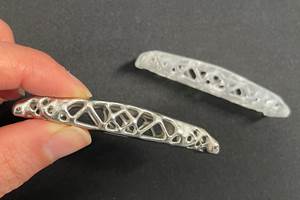Fixing Salt Spray Failures After Passivating, Baking
This is a common challenge faced by many acid zinc platers who Mark Adams from Columbia Chemical says perform hydrogen embrittlement relief on acid zinc plated fasteners.
Q. We run a barrel line with fasteners and, if we bake after passivating, we have salt spray failures. So we currently have to zinc plate, bake, activate (flash or nitric) and then passivate in order to get the corrosion protection we need. Why is this happening and is there an alternate option so we are not constantly double handling parts?
A: This is a common challenge faced by many acid-zinc platers who perform hydrogen embrittlement relief on acid zinc-plated fasteners while needing to adhere to the requirements of a corrosion resistance specification. The ideal process would be to zinc plate, passivate and then perform the hydrogen embrittlement relief step without the need to double handle parts.
Often, the first inclination is to process the zinc-plated fasteners in a thick film passivate (200+ Nm) designed to provide greater than 200 hours of resistance to white corrosion in neutral salt spray testing (NSST). However, it’s important to understand that following heat treatment, some thick film passivates substantially degrade and early onset NSST failures can occur. The most significant reason for early corrosion failure after hydrogen embrittlement relief is a high concentration of water within the passivate film. Reduced chromium density in the deposit can also be a contributing factor.
As traditional thick-film passivates build, they have a natural tendency to trap a large amount of water within the resulting film. Under normal operating conditions, the passivate will perform as intended. However, when introduced to high temperatures (400°F) during the hydrogen embrittlement relief stage, the water will evaporate. As the water evaporates, it causes a decrease in film thickness. The dehydration can damage the integrity of the passivate, leading to cracking and providing a means for early corrosion failures in neutral salt spray testing. The resulting decrease in film thickness is also significant because one of the primary ways passivate films inhibit corrosion is by acting as a simple barrier against the external environment. When that barrier is much thinner, it leads to a greater chance of early NSST failure. For example, a thick film passivate which provides >200 hours of corrosion protection under neutral salt spray testing may be reduced to only 48-72 hours of corrosion protection after heat treatment.
The good news is there are alternatives to traditional thick-film passivates. Newer technologies have developed thin-film passivates that offer comparable corrosion protection along with the ability to withstand hydrogen embrittlement relief. These newer thin-film technologies are designed to provide a layer that is comprised of chromium and cobalt in a tighter grain structure, compared to that of traditional thick-film passivates.
Considering the factors above allows us to better understand why corrosion protection is reduced during the bake stage with a traditional thick-film passivate. A newer technology thin-film passivate that is designed to withstand hydrogen embrittlement relief often has <100 nanometers of film thickness and will provide approximately 168 hours of corrosion protection in neutral salt spray testing. Significantly less water is incorporated into the film, which allows for a more stable annealing process. As a result, after the hydrogen embrittlement relief stage, the salt spray protection may only be reduced to 144 hours, which is a considerable improvement over a traditional thick-film passivate or the option of double handling parts.
In addition to selecting a newer technology thin-film passivate, options for sealers are available to further improve corrosion protection. Choosing the correct sealer that is designed to crosslink at elevated temperatures is key. A case in point comes from a plating shop that was failing to meet its corrosion resistance specifications. They were double handling the parts and only achieving 72 hours of corrosion protection under neutral salt spray testing, with a specification of 200 hours. After switching to a newer technology thin-film passivate and applying a crosslinking sealer designed to improve corrosion protection under elevated temperatures, the final parts surpassed 350 hours of corrosion protection in neutral salt spray testing. The plating shop transitioned back to a standard process that includes acid zinc-plating, passivating, sealer and then heat treatment, thereby completely eliminating the need to double handle the parts.
When faced with a scenario that requires double handling of parts in order to ensure corrosion protection is achieved after hydrogen embrittlement relief, it is best to discuss your potential options with a knowledgeable chemistry supplier. The use of newer technology thin-film passivates operating at lower thicknesses, while maintaining high levels of corrosion resistance even after hydrogen embrittlement relief, should eliminate the need to modify your standard processing steps.
Mark Adams is a technical account manager at Columbia Chemical. Visit columbiachemical.com.
Related Content
How to Maximize Nickel Plating Performance
The advantages of boric acid-free nickel plating include allowing manufacturers who utilize nickel plating to keep up the ever-changing regulatory policies and support sustainability efforts.
Read MorePossibilities From Electroplating 3D Printed Plastic Parts
Adding layers of nickel or copper to 3D printed polymer can impart desired properties such as electrical conductivity, EMI shielding, abrasion resistance and improved strength — approaching and even exceeding 3D printed metal, according to RePliForm.
Read MoreIn-House Blackening of Ferrous and Non-Ferrous Metals
Process satisfies customers’ shipping requirements while meeting stricter water regulations in times of drought.
Read MoreRead Next
The 2024 Ford Mustang: All the Colors Available
Although Chevrolet has announced the end of the Camaro and Dodge is offering “Last Call” editions of the Charger and Challenger, the Ford Mustang is launching to its seventh generation.
Read MoreEpisode 42: An Interview with Robin Deal, Hubbard-Hall
Hubbard-Hall wastewater treatment specialist Robin Deal discusses the latest trends in wastewater management.
Read MorePowder Coating 4.0: Smarter, Faster, More Efficient and Connected
New tools reduce cost and waste, lower manufacturing footprint of powder coating operations.
Read More

























